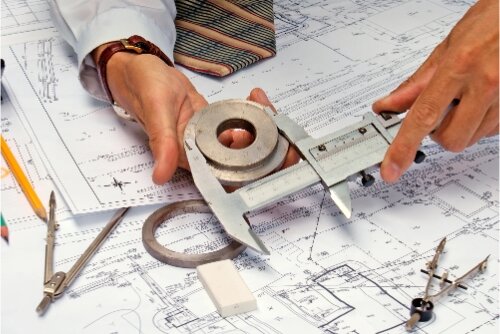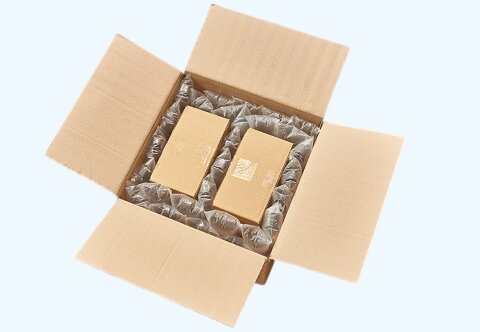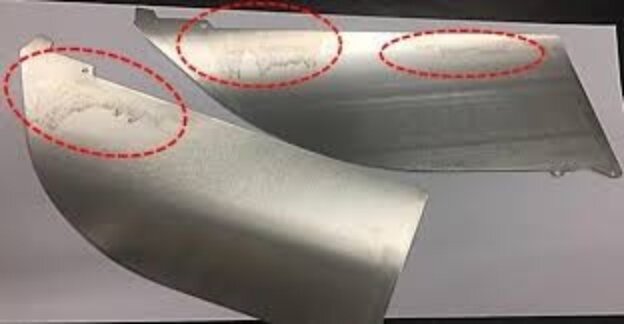Precision manufacturing demands cutting-edge techniques, and laser-cutting aluminum stands at the forefront. Many engineers and designers grapple with selecting the proper method for their projects. Laser cutting offers unparalleled accuracy and efficiency but comes with challenges and considerations, especially when working with aluminum.
Laser cutting aluminum is a precise method that uses a focused beam of light to melt and vaporize the metal. It offers advantages like clean edges, minimal material waste, and the ability to create complex designs. However, due to aluminum’s unique properties, including its high reflectivity and thermal conductivity, it requires specific equipment and expertise.
This post will explore the critical aspects of laser-cutting aluminum. We’ll cover the types of lasers and best practices to help you achieve optimal project results.
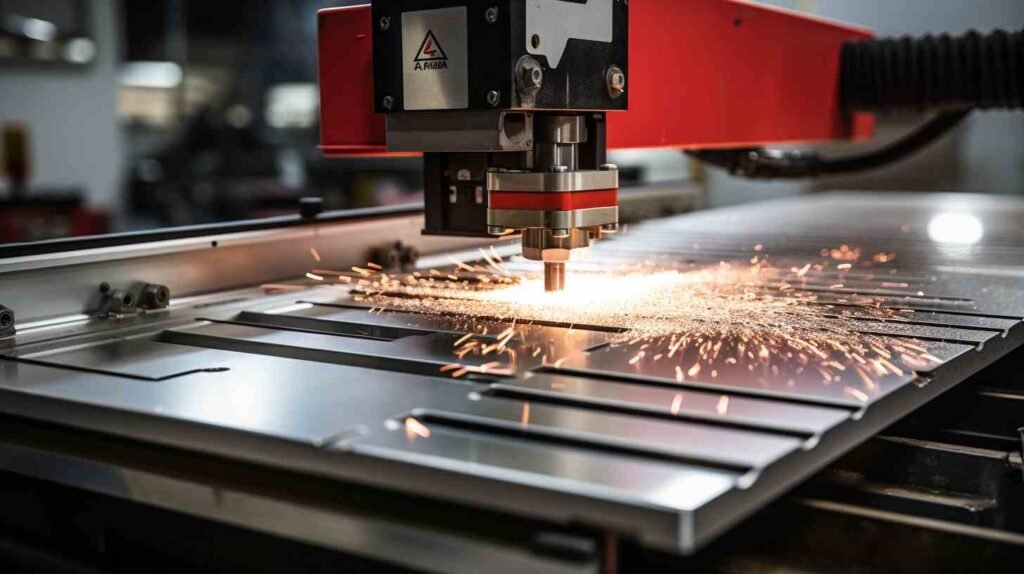
How Laser Cutting Aluminum Works: Basic Principles
Laser-cutting aluminum relies on focused, high-energy light beams to melt, vaporize, or burn away material. The process starts with a powerful laser that generates an intense light beam. This beam is then focused through a series of mirrors and lenses, concentrating its energy into a tiny spot.
When cutting aluminum, the laser’s heat quickly melts the metal. A pressurized gas stream, typically nitrogen or oxygen, blows away the molten material, creating a clean cut. The laser moves along a programmed path, guided by computer-controlled motors, to produce precise shapes and designs.
The key to effective laser cutting lies in balancing laser power, cutting speed, and assist gas pressure. These parameters need careful adjustment for aluminum to achieve clean cuts without excessive heat-affected zones or dross formation.
Different Laser Types for Aluminum Laser Cutting: Pros and Cons
Choosing the right laser type for aluminum cutting can significantly impact your project’s outcome. Here’s a breakdown of the leading laser types used for cutting aluminum, along with their pros and cons:
CO2 Lasers: Ideal for thinner aluminum sheets
Pros:
- Cost-effective for thin aluminum sheets (up to 3mm)
- The wide availability of machines and services
- Excellent edge quality on thin materials
Cons:
- It is less effective on thicker aluminum
- Higher power consumption compared to fiber lasers
- Requires more maintenance due to the complex beam delivery system
Fiber Lasers: More efficient for thicker aluminum and reflective surfaces
Pros:
- Highly efficient, especially for thicker aluminum (up to 25mm)
- Faster cutting speeds than CO2 lasers
- Better absorption by reflective materials like aluminum
- Lower operating costs and maintenance requirements
Cons:
- Higher initial investment cost
- It may produce rougher edges on fragile materials compared to CO2 lasers
Nd: YAG Lasers: Suitable for precision work
Pros:
- Suitable for precision work and small features
- Effective on both thin and moderately thick aluminum
- It can be used in pulsed mode for heat-sensitive applications
Cons:
- Generally slower cutting speeds compared to fiber lasers
- Higher maintenance requirements than fiber lasers
- Less energy-efficient than newer laser technologies
The choice between these laser types depends on your specific needs.
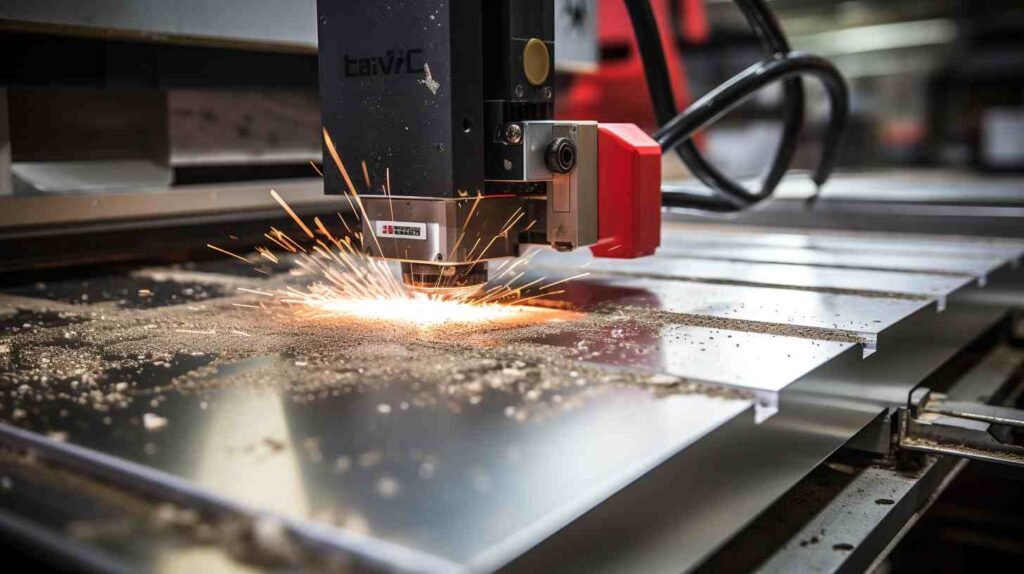
Tips and Techniques for Efficient Laser Cutting Aluminum
To achieve efficient and high-quality laser cutting of aluminum, optimizing various aspects of the process is crucial. Here are some essential tips and techniques:
Optimizing laser parameters
- Power: Adjust laser power based on material thickness. Higher power for thicker aluminum, lower for thin sheets.
- Speed: Find the sweet spot between speed and cut quality. Faster isn’t always better if it compromises the edge finish.
- Focus: Maintain proper focal length for sharp, clean cuts. This may vary depending on material thickness.
- Pulse frequency: For pulsed lasers, adjust frequency to control heat input and minimize thermal effects.
Using assist gases
- Nitrogen: Use for oxidation-free cuts, especially for decorative or visible parts.
- Oxygen: This can increase cutting speed but may produce an oxide layer on cut edges.
- Compressed air: A cost-effective option for non-critical parts or prototypes.
- Gas pressure: Adjust based on material thickness and desired cut quality.
Employing advanced nesting software
- Material utilization: Optimize part layout to minimize waste.
- Cut sequencing: Plan cutting paths to reduce heat buildup and thermal distortion.
- Standard line cutting: Share lines between adjacent parts to save time and material.
- Lead-in/lead-out optimization: Adjust entry and exit points to improve edge quality.
Fine-tuning these aspects can significantly improve cutting efficiency, reduce material waste, and enhance overall part quality when laser-cutting aluminum.
Critical Advantages of Laser Cutting Aluminum
Precision and Accuracy in Complex Designs
Laser cutting aluminum offers exceptional precision, allowing for intricate designs and tight tolerances. The focused laser beam can create sharp corners, small holes, and detailed patterns.
Faster Production Times and Efficiency Gains
Speed is a significant advantage of laser cutting. Once programmed, the laser cutter works quickly and consistently, reducing production times compared to manual cutting methods.
Minimal Material Waste
Laser cutting is a highly efficient process that minimizes material waste. The laser beam’s narrow kerf (width of the cut) means less aluminum is removed during cutting.
Reduced Need for Post-Cut Processing
The clean, precise cuts produced by laser cutting often require minimal post-processing. This reduces the need for secondary operations like deburring or sanding, saving time and labor costs.
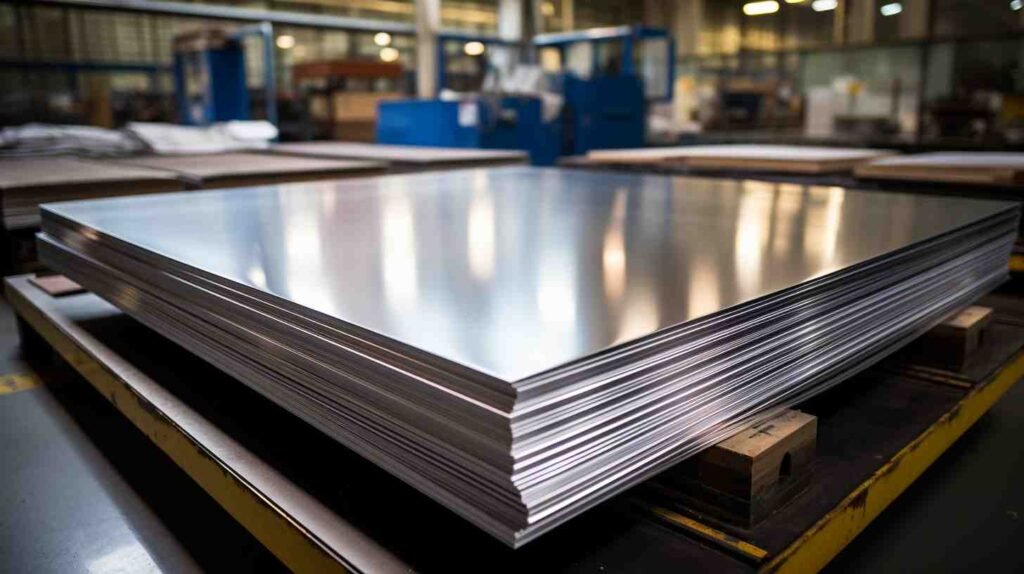
Comparing Laser Cutting Aluminum with Stainless Steel and Other Materials
Let’s compare laser cutting aluminum to stainless steel and other common materials:
Aluminum vs. Stainless Steel
- Cutting speed: Aluminum cuts 30-50% faster than stainless steel of the same thickness
- Power requirements: Aluminum needs 20-30% less laser power
- Reflectivity: Aluminum is more reflective, requiring careful parameter adjustment
- Heat conductivity: Aluminum dissipates heat quickly, potentially affecting cut quality
Aluminum vs. Mild Steel
- Oxidation: Aluminum doesn’t rust, unlike mild steel
- Assist gas: Nitrogen is preferred for aluminum; oxygen is often used for mild steel.
- Cutting efficiency: Mild steel typically cuts faster than aluminum
Aluminum vs. Acrylic
- Edge finish: Acrylic produces smoother, flame-polished edges
- Fume extraction: Aluminum cutting generates less harmful fumes
- Thickness range: Lasers cut thicker acrylic sheets compared to aluminum
Aluminum’s Reflective Nature: Challenges and Solutions
Aluminum’s high reflectivity poses significant challenges in laser-cutting operations. If not properly managed, this characteristic can reduce cutting efficiency and potentially damage equipment.
The primary issue with aluminum’s reflectivity is that it reflects a large portion of the laser energy, reducing the amount absorbed by the material. This reflection can lead to slower cutting speeds, incomplete cuts, or increased power requirements. In extreme cases, reflected laser beams can damage the cutting head or other machine components.
To address these challenges, several strategies can be employed:
- Use fiber lasers: Fiber lasers operate at wavelengths that aluminum absorbs more readily than CO2 lasers. This improved absorption leads to more efficient cutting and reduced reflection issues.
- Adjust cutting parameters: Increasing laser power and reducing cutting speed can help overcome reflectivity issues. However, this approach requires careful balancing to avoid overheating the material.
- Apply anti-reflective coatings: Temporary coatings can be applied to the aluminum surface to reduce reflectivity. These coatings absorb laser energy more effectively, improving cut quality and reducing the risk of beam reflection.
- Utilize assist gases: Proper use of assist gases, particularly oxygen for thicker materials, can help manage heat and improve cut quality by promoting exothermic reactions.
Manufacturers can achieve high-quality cuts by understanding and addressing aluminum’s reflective nature while maintaining safe and efficient operations.

Overcoming Common Challenges in Laser Cutting Aluminum
Laser cutting aluminum, while highly effective, comes with its challenges. Recognizing and addressing these issues is critical to achieving optimal results. Here are some common challenges and strategies to overcome them:
Heat-affected zone (HAZ)
Aluminum’s high thermal conductivity can lead to a larger HAZ, potentially causing warping or altering material properties.
- Use higher cutting speeds with adjusted power settings
- Implement proper cooling techniques, such as air or water cooling
- Consider using pulsed laser systems for better heat control
Dross formation
Molten aluminum can re-solidify on the bottom edge of the cut, forming dross.
- Optimize cutting speed and power settings
- Use nitrogen as an assist gas for thin sheets
- Employ oxygen-assist gas for thicker materials to promote exothermic reactions
Oxide layer formation
Aluminum quickly forms an oxide layer when exposed to air, which can affect cut quality.
- Use a dual-gas nozzle system with an inert gas to protect the cut zone
- Maintain a clean cutting environment to minimize oxidation
Burr formation
Burrs can occur on the bottom edge of cuts.
- Fine-tune cutting speed and power settings
- Use sharp focus and maintain proper standoff distance
- Consider post-processing techniques for critical applications
By addressing these challenges systematically, manufacturers can significantly improve the quality and consistency of laser-cut aluminum components.
Conclusion
Laser cutting aluminum offers a powerful combination of precision, speed, and versatility for modern manufacturing. While it presents unique challenges due to aluminum’s reflective nature and thermal properties, these can be overcome with the proper techniques and equipment.
By understanding the factors influencing cut quality and implementing appropriate strategies, manufacturers can harness the full potential of laser cutting for aluminum components.
Do you need a reliable sheet metal parts manufacturer? Shengen is the place to go. We specialize in sheet metal laser cutting, stamping, surface finish, and CNC Machining. Reach out to Shengen Today and seek help from professionals!
FAQs
What is the maximum thickness of aluminum that can be laser cut?
The maximum thickness depends on the laser type and power. Fiber lasers can cut aluminum up to 1 inch thick, while CO2 lasers are effective up to about 0.5 inches. For thicker materials, other cutting methods may be more suitable.
How does laser cutting affect the strength of aluminum?
Laser cutting generally has minimal impact on aluminum’s overall strength. The heat-affected zone is usually tiny, and any changes in material properties are localized to the cut edge. Proper cutting parameters help maintain the aluminum’s structural integrity.
Is laser cutting aluminum a cost-effective method?
Laser cutting aluminum is often cost-effective, especially for complex designs or large production runs. While initial equipment costs are high, the process offers fast production times, low material waste, and reduced need for post-processing, leading to overall cost savings.
What are the most common industries using laser-cut aluminum today?
Laser-cut aluminum is frequently used in the aerospace, automotive, electronics, signage, and architectural industries. It’s also popular in prototyping, custom manufacturing, and consumer goods production.
How does laser cutting aluminum compare to other methods in terms of speed?
Laser cutting is generally faster than traditional methods like sawing or milling, especially for complex shapes. It’s comparable to plasma cutting in speed for thin materials but offers better precision. For very thick aluminum, waterjet cutting might be faster.
Hey, I'm Kevin Lee

For the past 10 years, I’ve been immersed in various forms of sheet metal fabrication, sharing cool insights here from my experiences across diverse workshops.
Get in touch

Kevin Lee
I have over ten years of professional experience in sheet metal fabrication, specializing in laser cutting, bending, welding, and surface treatment techniques. As the Technical Director at Shengen, I am committed to solving complex manufacturing challenges and driving innovation and quality in each project.


